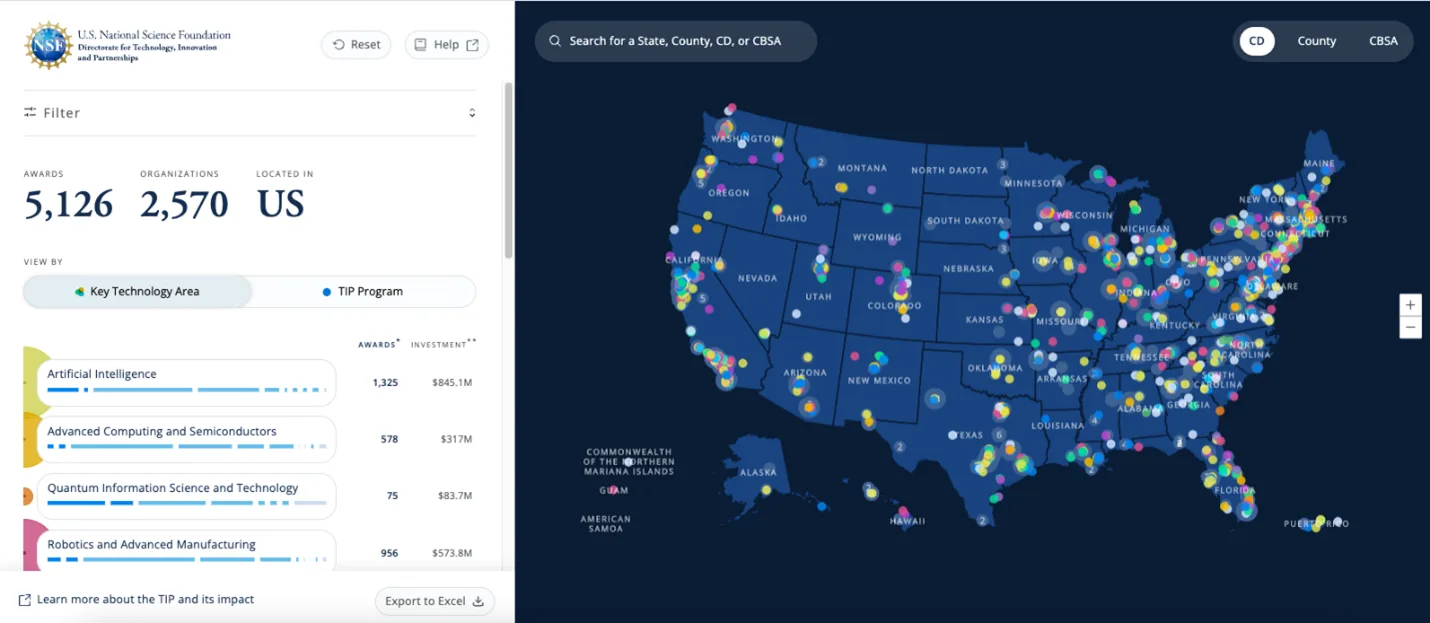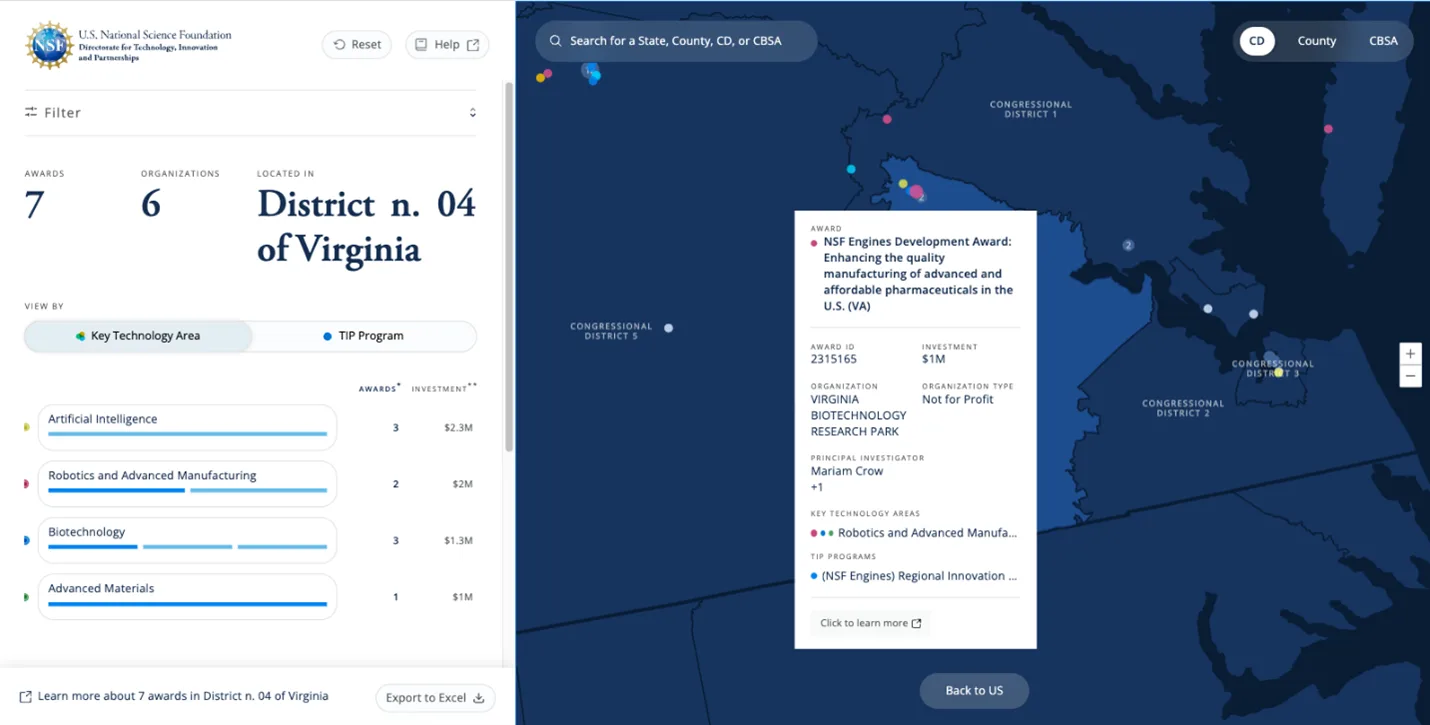From funding to foresight: How NSF’s TIP directorate is redefining research investment through data-driven insight
August 20, 2025 | 15 min read
By Ann Gabriel

Andriy Onufriyenko via Getty
As science and technology shape economic prosperity, national security, and public well-being, research funders around the world face a defining question: How can we ensure that public investments in research deliver real-world impact?
The second part of this story, examining how NSF’s TIP platform democratizes innovation and workforce development across the U.S. is available here.
The question is central to a global policy shift where funding decisions must demonstrate not just academic excellence, but also measurable outcomes aligned with societal needs. Across governments and agencies, there is growing pressure to rethink how we define value in research. In the United States, the National Science Foundation’s (NSF) Directorate for Technology, Innovation and Partnerships , or TIP has taken up this challenge.
Established in 2022, TIP represents a new mandate within the U.S. federal science funding landscape. Its three-pronged mission is to accelerate progress in critical technologies, build inclusive regional innovation ecosystems, and prepare the U.S. workforce for the future. This calls for insight, agility, and accountability.
To that end, TIP has launched an innovative platform: the TIP Investments pilot. This public-facing portal allows users to explore, map, and analyze nearly 5,000 TIP grants awarded since the directorate’s founding. Erwin Gianchandani, NSF assistant director for TIP commented.
"We are thrilled to launch this pilot capability to allow the American public a new way of seeing the breadth and depth of TIP’s investments in key technology areas."

NSF-TIP Investment Pilot Dashboard Powered by Pure
NSF-TIP Investment Pilot Dashboard Powered by Pure
From artificial intelligence to biotechnology, from quantum computing to advanced manufacturing, the platform provides unprecedented visibility into who is receiving funding, where investments are located, and which areas of national interest they support.
The pilot moves beyond basic search to support transparency, teamwork, and more informed decisions.
Investments that Accelerate Research to Impact
For much of the 20th century, research was primarily curiosity-driven. It advanced knowledge through fundamental inquiry, often without immediate application. That foundation remains vital. But today, we face intertwined global crises: climate change, public health challenges, geopolitical instability, and economic inequality. Research agendas must now operate in a dual mode, pursuing discovery while also delivering solutions.
This growing emphasis on society-driven research is transforming how research value is measured. It’s no longer enough to count publications or citations. Funders must show how investments stimulate innovation, empower communities, foster inclusive growth, and generate long-term societal returns.
Data alone is not enough. What’s needed is the ability to derive critical insights from data - to tell stories that connect funding to outcomes, to inform policy and investment, and to catalyze new opportunities for collaboration.
The TIP Investments Pilot: Data in Action
Launched in July 2024, the TIP Investments pilot is designed to do exactly that. Built as part of a collaboration with Elsevier’s Pure platform and using publicly available NSF award data, the platform provides an intuitive interface to explore the scale, distribution, and purpose of NSF-TIP’s investments.
Users can navigate the data by geography (state, territory, congressional district, county, or metro area), by program pillar, or by one of ten Key Technology Areas (KTAs) defined as critical for U.S. competitiveness. These include:
Artificial Intelligence
Advanced Communications
Advanced Computing and Semiconductors
Advanced Energy and Industrial Efficiency Technologies
Advanced Materials
Data and Cybersecurity
Disaster Prevention and Mitigation
Biotechnology
Quantum Information Science & Technology
Robotics and Advanced Manufacturing
We hope that the map and underlying data will help those interested in TIP’s investments explore our work and assist researchers in finding others in their regions or focus areas.
Erwin Gianchandani, Dr
NSF Assistant Director for Technology, Innovation and Partnerships
Each grant is tagged and visualized through a dynamic, interactive map. Click on a dot, and you see the institutions, principal investigators, and technology domains linked to that investment. Drill down further, and you can uncover regional patterns, program alignments, and institutional collaborations.

Number and total funding of TIP awards in the 4th Congressional district of Virginia, with inset providing award details
“We hope that the map and underlying data will help those interested in TIP’s investments explore our work and assist researchers in finding others in their regions or focus areas,” said Dr. Gianchandani said.
What makes this pilot transformative is not just its accessibility, but its strategic potential. Funders can assess how investments are distributed across regions and sectors. Universities can identify potential collaborators. Policymakers can understand where innovation clusters are forming, and where gaps remain.
“From an entrepreneur’s perspective, we’ve already heard that some didn’t realize how many TIP investments were in their region. One also said he was developing a specific technology, but he lacked expertise in STEM Education and workforce development—through this platform, he found the right experts and connected with them.” said Grace Yuan, Data Analytics Officer at NSF-TIP. “So we are already seeing the capacity of the platform to catalyze the collaboration and innovation already. One non-profit working in STEM education told us how useful they found the new TIP investments map—. Not only did it help them understand the breadth of TIP’s investments it made it easier to connect with others working in similar areas. They also mentioned how slick it looked!"
From an entrepreneur’s perspective, we’ve already heard that some didn’t realize how many TIP investments were in their region. One also said he was developing a specific technology, but he lacked expertise in STEM Education and workforce development—through this platform, he found the right experts and connected with them.
Grace Yuan
Data Analytics Officer for the Directorate for Technology, Innovation, and Partnerships (TIP) at National Science Foundation (NSF)
Contributor
